Introduction: Why Podcasts Matter Now
A few years ago, podcasts were what you threw on during a long commute or while folding laundry—low-key, often DIY, and mostly under the radar. Now? They’re front and center in the media world. From underground true-crime series to polished interviews with CEOs and celebrities, podcasts are no longer a side gig. They’re a primary channel.
What’s behind the boom? On-demand audio fits the way people actually live. No screen, no fixed schedule, just hit play and carry on. That flexibility has carved out a permanent space for podcasts in a media landscape overloaded with noise and distraction. It’s personal, it’s portable, and it doesn’t fight for your full attention the way video does.
The shift from niche to mainstream didn’t happen overnight. It’s the result of years of growing trust between podcasters and their listeners. Audiences have formed tight bonds with voices that speak directly to their interests and their lives. That kind of connection is hard to fake—and worth paying attention to.
Podcasts vs. Traditional Media
Podcasts aren’t just a format—they’re a different kind of experience. They don’t require screens or schedules. You can listen on a run, in your car, or in the dead quiet of a late-night room. That kind of flexibility makes podcasts fit into people’s lives without competing for their full attention. But what really gives them weight is intimacy. Hosts speak directly into your ears. There’s no news anchor voice, no corporate gloss, just a person talking. That kind of connection builds trust fast—and it sticks.
Unlike traditional radio, podcasts aren’t shackled by airtime limits or broad audience expectations. They’re weird, personal, specific. A show can thrive with 2,000 loyal listeners who care, instead of chasing millions who don’t. Add in the fact that creators keep more control—no broadcast gatekeepers, no rush to be advertiser-friendly—and you’ve got a medium built for independence.
Same goes for streaming video. While video craves attention and flashy visuals, audio prioritizes story and tone. It slows things down, lets ideas breathe. That’s a challenge to platforms obsessed with speed and polish. Podcasts aren’t trying to replace anything. They’re carving a lane no one else is in—and doing it on their own terms.
Who’s Listening and Why It Matters
Podcasts aren’t just for tech bros and true crime junkies anymore. The audience has broadened—and gotten smarter. Gen Z, millennials, and even Gen X are all tuning in, cutting across interests from self-help to politics to obscure comedy. What unites them? They’re busy. They want content that moves with them—on commutes, dog walks, grocery runs. Podcasts fit into cracks where video and text don’t.
Unlike fast-scroll social feeds, podcast listeners are sticking around. Average listening time is way up, especially in long-form formats. People aren’t just skimming—they’re digesting. And they’re loyal: once someone locks into a voice or a show, they come back week after week. That kind of engagement is gold in today’s fractured attention economy.
Understanding these patterns isn’t just trivia. For creators, it means crafting shows that respect time but still offer richness. For brands, it means tapping into a medium where trust is already built in.
The Content Explosion
Podcasts aren’t just filling in gaps left by traditional media—they’re kicking down the doors entirely. Topics that once belonged to dusty forums or underground zines now live in full surround sound. You want two hours on the ethics of urban foraging? There’s a show for that. Weekly updates on queer astrophysics or Afro-Caribbean folklore? Those exist, with loyal listeners tuning in from all over. This is the golden age of niche content.
Hyper-targeted shows aren’t a side effect—they’re the main event. These podcasts serve small but passionately engaged groups, creating communities that live beyond the feed. For creators, that means fewer filters, more freedom, and deeper feedback loops than most media has ever offered.
Audio has a unique advantage: it lets stories breathe. Without the visual noise, listeners immerse themselves in tone, pause, rhythm. You’re not just hearing a tale—you’re inside it. And in a world obsessed with speed and snapshots, that kind of depth hits different. It sticks. It resonates. It builds trust.
The content explosion isn’t about more noise. It’s about more truth—told in voices that finally have the space to dig in.
Monetization in the Podcast Era
Podcast money used to come from a few ad reads squeezed between rambling intros. Now, it’s a whole ecosystem. Sponsorships still lead the charge, with brands eager to tap into tight-knit listener bases. But the model is diversifying. Affiliate links, direct purchases, and even in-episode promotions are carving out real revenue streams—especially for smaller hosts with a loyal niche.
Listener-supported platforms like Patreon and Supercast are gaining serious traction. Audiences are showing they’ll pay for content that feels authentic and consistent. Which explains why indie podcasts with no big-budget backing are often more profitable (and sustainable) than studio shows. They’re plugged into communities, not just pushing content.
Then there’s the exclusive deal arms race. Platforms like Spotify and Amazon have bagged high-profile names behind the paywall, betting on loyalty and premium access. It’s sparked a debate: does paywalling sacrifice audience reach for short-term gain? Some say yes. Others say it’s inevitable if podcasting wants to survive as a serious media contender.
Still, the lesson is clear. In 2024, monetization is about connection, not scale. The shows that win are the ones that know their audience—and serve them something worth coming back (and paying) for.
Technology’s Role in Driving Growth
In the podcasting world, technology isn’t just a tool—it’s the fuel behind the medium’s rapid evolution. From creation to distribution, a wave of innovations is helping more creators break through, while also enriching the listener experience.
Low Barrier to Entry: Create Without the Gatekeepers
Thanks to user-friendly tech, podcast production no longer requires a professional studio or large upfront investment. Today’s tools make it easier than ever to launch a high-quality show on a budget.
- Mobile apps and web-based platforms simplify recording and editing
- Affordable equipment like USB microphones and plug-and-play mixers improve audio quality
- Hosting services offer all-in-one solutions for publishing and analytics
Smarter Discovery: How Listeners Find What They Love
With so many podcasts available, platforms are racing to make content easier to find and follow. Smarter recommendation engines are reshaping how new shows gain traction.
- Algorithms analyze listener habits to suggest relevant episodes
- Curated playlists help surface niche content
- Search features increasingly support topic-based browsing, not just show titles
AI Is Shaping the Next Generation of Podcasting
Artificial intelligence is quickly becoming the silent partner behind every successful show. From automation to personalization, AI unlocks efficiencies and insights that previously weren’t possible.
- AI tools automate editing, improving workflow and saving time
- Auto-generated transcripts boost accessibility and SEO
- Intelligent ad targeting enhances monetization without disrupting the listener experience
For more on this topic, check out How Artificial Intelligence Is Transforming Media Production
Technology is turning podcasting into one of the most accessible and dynamic formats in modern media. As innovation continues, expect an even greater surge of content—crafted smarter, distributed faster, and tailored with precision.
Challenges Ahead
As the podcasting space continues to grow, it brings not only opportunities but also a set of new and pressing challenges. While more creators and listeners enter the field every day, standing out, maintaining quality, and addressing ethical concerns are becoming critical for long-term success.
Discovery Overload: Breaking Through the Noise
There are now millions of podcasts across every major platform. The entry barrier may be low, but the competition for sustained attention is high.
- Listeners are overwhelmed with options, often choosing shows based purely on familiar hosts or curated platform recommendations.
- New creators must craft standout branding, unique angles, and high-value content to rise above the noise.
- Niche positioning and word-of-mouth remain powerful tools for organic discovery.
Tip: Focus on building a strong hook and consistent value proposition, not just dropping episodes. Podcasts that solve specific problems or serve pointed communities often shine brighter.
Quality vs. Quantity: Growth at a Cost
In the race to publish frequently and gain momentum, many shows compromise on production value or editorial standards.
- Rapid growth has resulted in a flood of under-edited, repetitive, or derivative content.
- Consistency matters, but thoughtful pacing often wins over rushed publishing.
- Creators need to balance staying visible without diluting the listener experience.
Reminder: Quality content builds trust—and trust drives retention. It’s better to delay an episode than to compromise its impact.
Ad Tech and Data Privacy Concerns
As more advertisers invest in the space, advanced ad technologies have entered podcasting—with consequences.
- Dynamic ad insertion and listener tracking raise privacy issues, especially with emerging regulations.
- Transparency around data collection and sponsorships is becoming essential for credibility.
- Some platforms face backlash for prioritizing monetization over user control.
Action Step: Stay informed on evolving privacy laws (like GDPR and CCPA) and consider clearly disclosing ad practices to foster listener trust.
The road ahead for podcasting is full of promise—but navigating these challenges with intention is what will separate sustainable creators from short-lived noise.
Where It’s All Going
Podcast networks aren’t just bundling shows anymore—they’re building ecosystems. Think content arms that also handle documentaries, live events, newsletters, and viral TikToks. The line between podcasting and other media is blurring fast, and creators who play across formats are staying ahead. Cross-media strategy is less about stretching yourself thin and more about reinforcing your story. A good podcast isn’t just a feed—it’s a brand.
Video-podcasts are part of that shift. And yes, they’re getting louder. Platforms like YouTube and Spotify are doubling down on video because visuals drive discovery and engagement. But here’s the reality check: cameras won’t save a show with nothing to say. Flashy sets and multi-cam angles don’t replace narrative, presence, or point-of-view. Video helps—but voice leads.
At the end of the day, the heart of podcasting hasn’t changed. It’s still about lone voices, real conversations, and stories told without interruption. As tech evolves and networks expand, the creators who endure will be the ones who stay raw, well-rooted, and wholly themselves.



